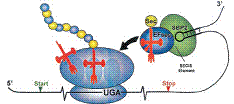Biochemistry, Department of

Vadim Gladyshev Publications
Document Type
Article
Date of this Version
2008
Abstract
Proteins containing the 21st amino acid, selenocysteine (Sec), have been described in all three domains of life, but the composition of selenoproteomes in organisms varies significantly. Here, we report that aquatic arthropods possess many selenoproteins also detected in other animals and unicellular eukaryotes, and that most of these proteins were either lost or replaced with cysteine-containing homologs in insects. As a result of this selective selenoproteome reduction, fruit flies and mosquitoes have three known selenoproteins, and the honeybee, Apis mellifera, a single detected candidate selenoprotein. Moreover, we identified the red flour beetle, Tribolium castaneum, and the silkworm, Bombyx mori, as the first animals that lack any Sec-containing proteins. These insects also lost the Sec biosynthesis and insertion machinery, but selenophosphate synthetase 1 (SPS1), an enzyme previously implicated in Sec biosynthesis, is present in all insects, including T. castaneum and B. mori. These data indicate that SPS1 functions in a pathway unrelated to selenoprotein synthesis. Since SPS1 evolved from a protein that utilizes selenium for Sec biosynthesis, an attractive possibility is that SPS1 may define a new pathway of selenium utilization in animals.


Comments
Published in Protein Science (2008), 17:176–182. Published by Cold Spring Harbor Laboratory Press. Copyright © 2008 The Protein Society. Used by permission.